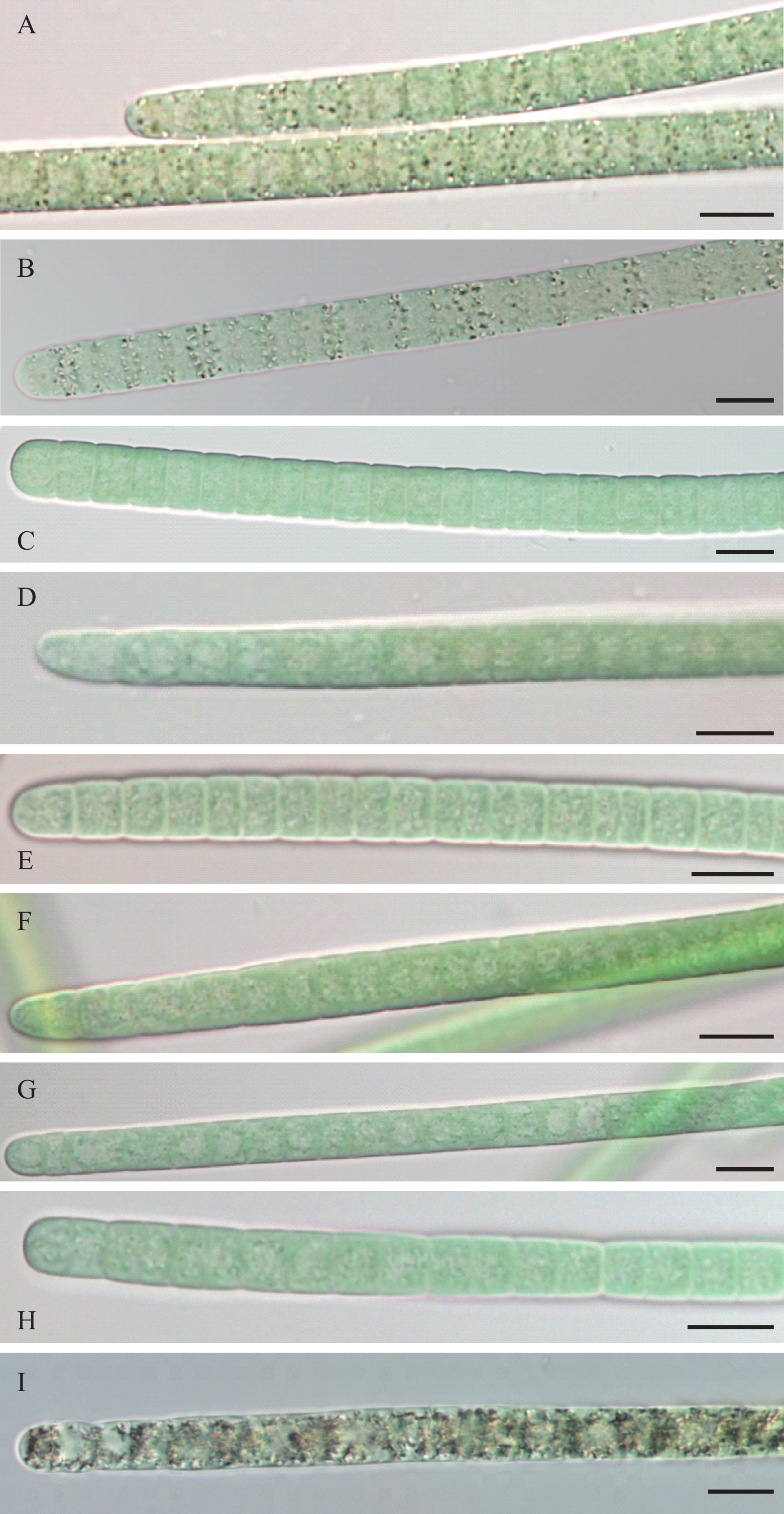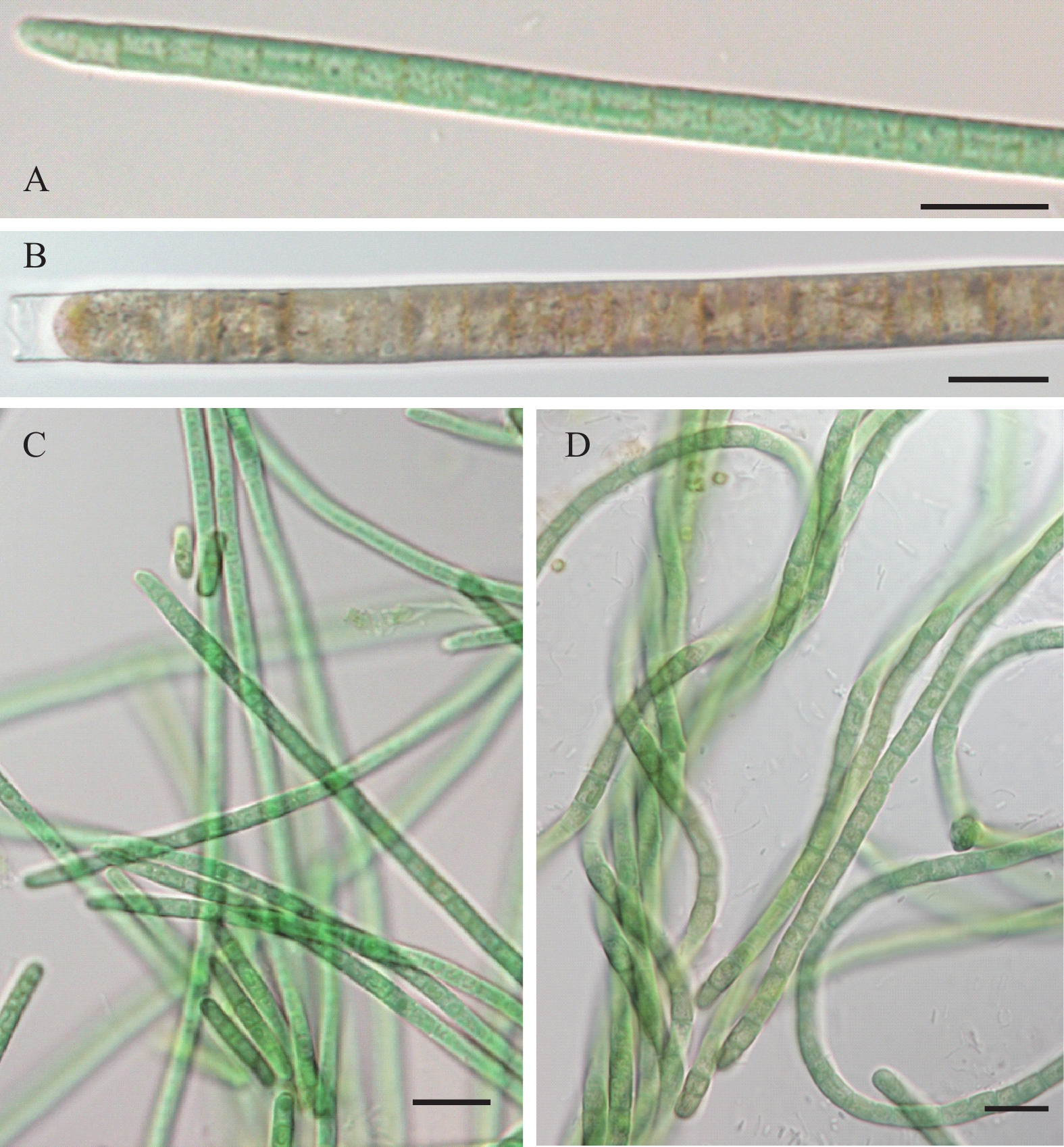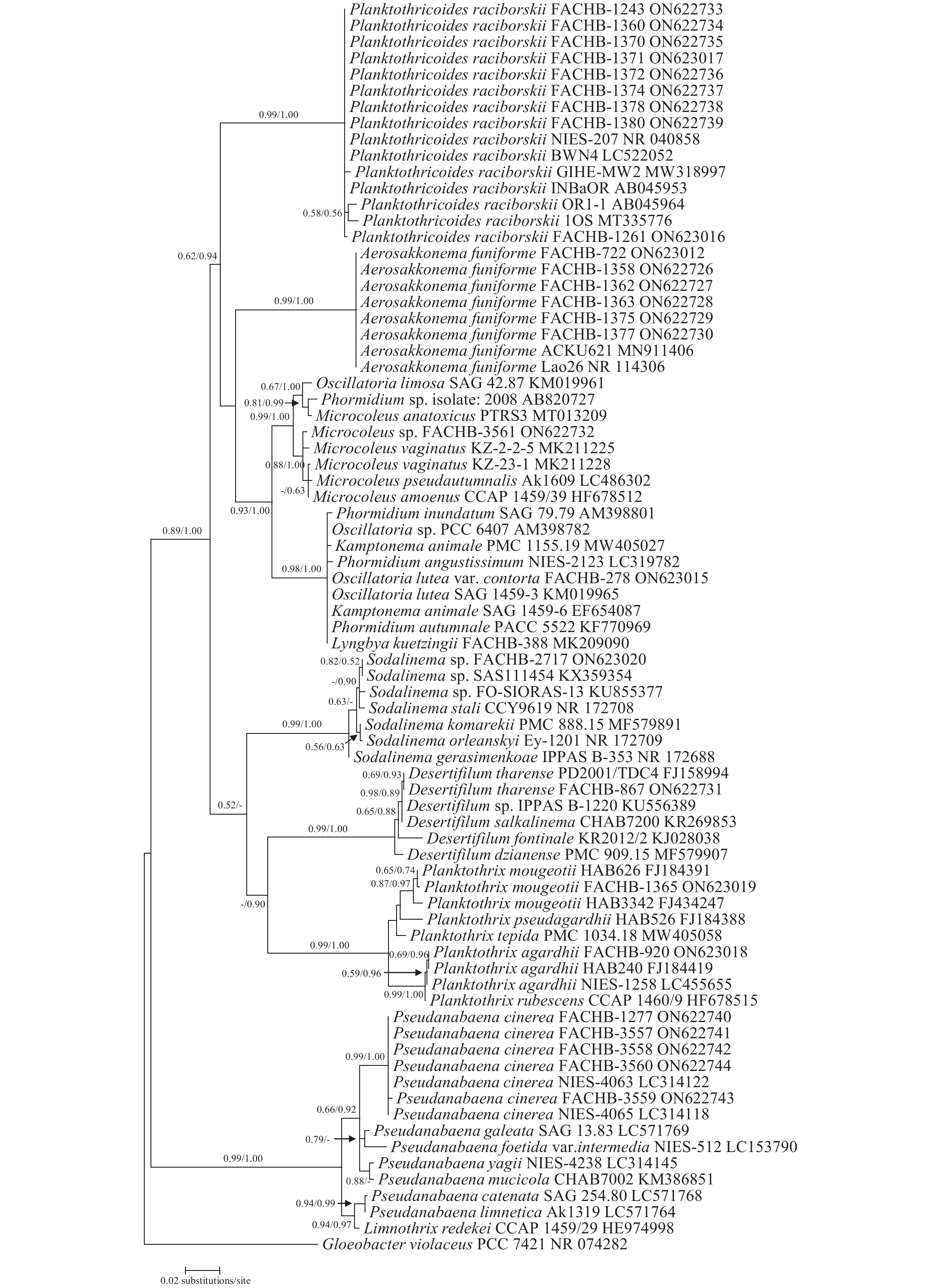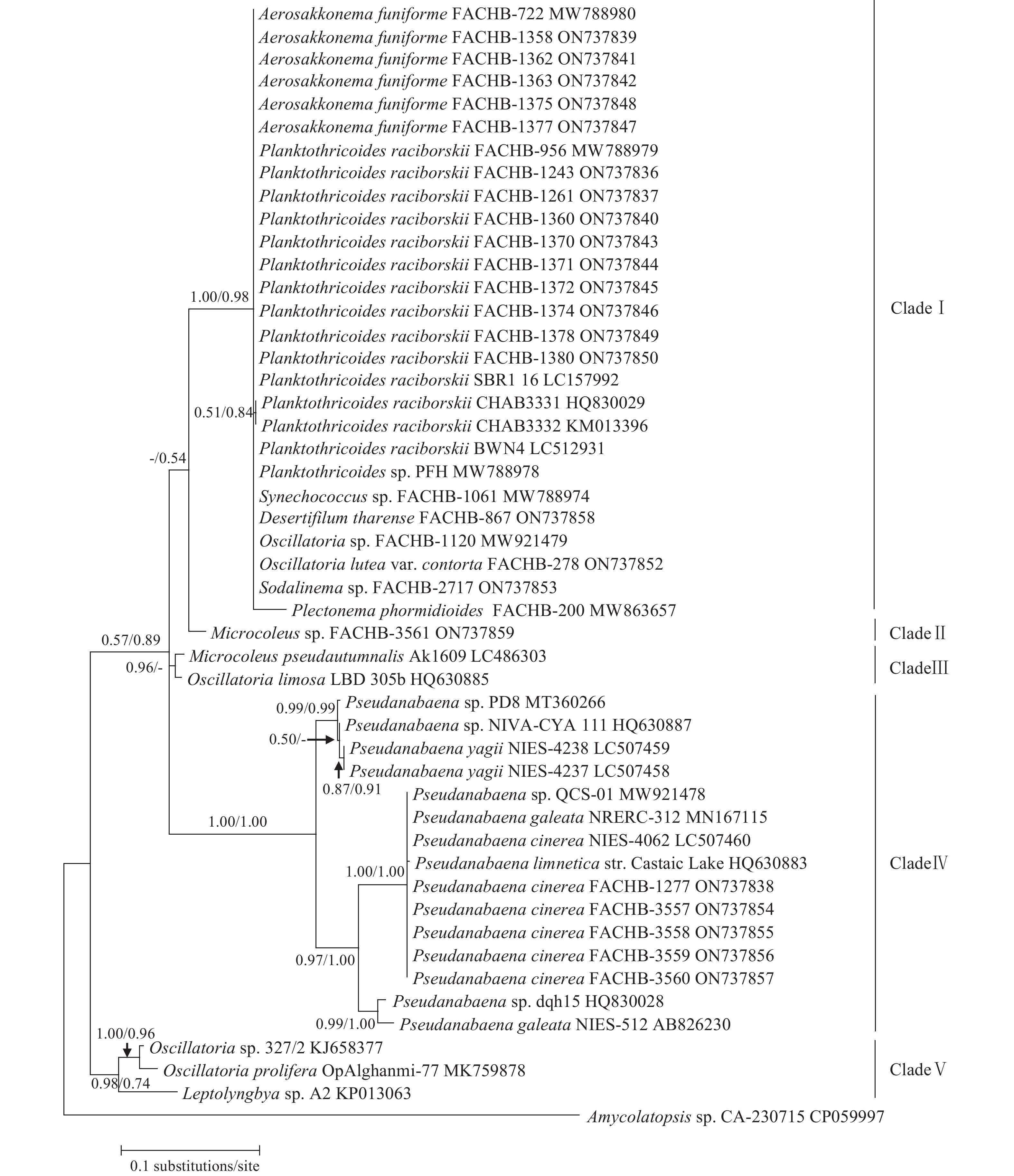IDENTIFICATION AND CHARACTERIZATION OF 2-MIB-PRODUCING CYANOBACTERIA IN FACHB
-
摘要: 为认识产二甲基异莰醇(2-MIB)蓝藻的形态和产嗅特征, 从国家水生生物种质资源库淡水藻种库中筛选出24株可产2-MIB藻株, 描述了这些藻株的形态特征和生境分布。结合形态和16S rRNA基因分析对藻株进行物种鉴定复核, 修订了部分库藏藻株物种名称, 例如发现库藏产2-MIB的浮丝藻属种类应当被重新鉴定为拉氏拟浮丝藻或索状气丝藻。基于mic基因系统发育树分析, 显示蓝藻mic基因形成5个分支。通过2-MIB含量检测发现, 不同藻株间单个细胞总2-MIB含量为6—2549 fg/cell, 其含量通常为拉氏拟浮丝藻>索状气丝藻>灰假鱼腥藻。研究提供了产2-MIB蓝藻的形态、分子、生态和产嗅特性等的基础数据, 首次报道气丝藻、沙丝藻、苏打丝藻种类可产2-MIB, 并在国内首次报道了产2-MIB的微鞘藻, 为进一步研究产2-MIB蓝藻生理生态特性提供重要的实验材料和科学依据。Abstract: Odor problems in freshwater caused by 2-methylisoborneol (2-MIB) have received much attention in China recently. The odorous 2-MIB in freshwater is known to be mainly produced by a group of filamentous cyanobacteria which cause offensive taste and odor in drinking water and fish catch. From the detection of MIB synthase gene and GC/MS analyses, 24 strains of 2-MIB-producing cyanobacteria were detected in Freshwater Algae Culture Collection at the Institute of Hydrobiology (FACHB-collection), National Aquatic Biological Resource Center, the largest microalgal culture collection in China. These strains were re-identified as Planktothricoides raciborskii (Wołoszyńska) Suda & Watanabe, Aerosakkonema funiforme Thu & Watanabe, Pseudanabaena cinerea Tuji & Niiyama, Oscillatoria lutea var. contorta Baker et Bold, Microcoleus sp., Desertifilum tharense Dadheech & Krienitz and Sodalinema sp. by morphological descriptions and molecular characteristics based on the 16S rRNA gene, respectively. Most 2-MIB-producing strains of Planktothrix in FACHB-collection should be re-identified as P. raciborskii or A. funiforme. This was the first report of 2-MIB-producing filamentous cyanobacteria of Aerosakkonema, Desertifilum and Sodalinema in the world, and was also the first report of 2-MIB-producing Microcoleus in China. The phylogenetic analyses base on 16S rRNA gene indicated that 2-MIB-producing strains in FACHB-collection were placed on seven separated clades, which reflected true taxonomic relationships. The genera Planktothricoides, Aerosakkonema, Pseudanabaena, Microcoleus, Desertifilum and Sodalinema formed six monophyletic clades in 16S rDNA tree; however, O. lutea var. contorta was closely related to some strains of Oscillatoria, Phormidium and Kamptonema. The phylogenetic analyses based on mic gene indicated that 2-MIB-producing cyanobacteria strains formed five clades with high support values. 2-MIB-producing P. raciborskii and A. funiforme were clustered into Clade I in mic tree. Two 2-MIB-producing Microcoleus strains were placed on Clade Ⅱ and Ⅲ, respectively. All 2-MIB-producing Pseudanabaena strains were clustered into Clade Ⅳ. Phylogenetic topology of some 2-MIB-producing strains in mic tree were incongruent with the topology in 16S rDNA tree. Cell quota of 2-MIB produced by these strains may vary in a wide range, varying from 6—2549 fg/cell. Cell quota of 2-MIB varied considerably among species, such as P. raciborskii > A. funiforme > P. cinerea. The results provide important experimental materials and basic data on morphological, molecular, ecological and 2-MIB-producing characteristics of filamentous cyanobacteria, and contribute to understanding ecophysiological characteristics 2-MIB-producing cyanobacteria.
-
Keywords:
- 2-methylisoborneol /
- Filamentous cyanobacteria /
- Odor /
- Morphological characteristics /
- mic gene
-
-
图 2 库藏索状气丝藻和灰假鱼腥藻藻株显微照片
索状气丝藻: A. FACHB-1358; B. FACHB-1362; C. FACHB-1363; D. FACHB-1375; E. FACHB-1377;灰假鱼腥藻: F. FACHB-1277; G. FACHB-3557; H. FACHB-3558; I. FACHB-3559; J. FACHB-3560; 标尺, 10 μm
Figure 2. Micrographs of Aerosakkonema funiforme and Pseudanabaena cinerea strains in FACHB
A. funiforme: A. FACHB-1358; B. FACHB-1362; C. FACHB-1363; D. FACHB-1375; E. FACHB-1377; P. cinerea: F. FACHB-1277; G. FACHB-3557; H. FACHB-3558; I. FACHB-3559; J. FACHB-3560; Scale bars, 10 μm
图 3 库藏黄颤藻扭曲变种FACHB-278(A)、微鞘藻FACHB-3561(B)、塔尔沙丝藻FACHB-867(C)和苏打丝藻FACHB-2717(D) 藻株显微照片(标尺, 10 μm)
Figure 3. Micrographs of FACHB strains of Oscillatoria lutea var. contorta FACHB-278(A), Microcoleus sp. FACHB-3561(B), Desertifilum tharense FACHB-867(C) and Sodalinema sp. FACHB-2717(D) (Scale bars, 10 μm)
图 4 基于蓝藻16S rRNA基因序列构建的最大似然树
节点上的数值代表分别用最大似然法和贝叶斯法所得当前进化枝的自展支持(BP)和后验概率(PP), 仅显示高于0.50的支持值
Figure 4. Maximum-likelihood tree based on 16S rRNA gene from cyanobacteria
The numbers on the nodes indicate the bootstrap support values (BP)/posterior probabilities (PP) based on Maximum Likelihood and Bayesian Inference. Only values>0.50 for BP or PP are shown
图 5 基于蓝藻mic基因序列构建的最大似然树
节点上的数值代表分别用最大似然法和贝叶斯法所得当前进化枝的自展支持(BP)和后验概率(PP), 仅显示高于0.50的支持值
Figure 5. Maximum-likelihood tree based on mic gene from cyanobacteria
The numbers on the nodes indicate the bootstrap support values (BP)/posterior probabilities (PP) based on Maximum Likelihood and Bayesian Inference. Only values>0.50 for BP or PP are shown
表 1 FACHB库藏产2-MIB蓝藻藻株信息
Table 1 List of 2-MIB-producing cyanobacterial strains in FACHB
藻株编号
Strain No.库藏物种
Species in publication修订后的学名
Revised nomenclature来源地
Geographic origin生境类型
Habitat16S rRNA
(GenBank
序列号)
16S rRNA (GenBank
accession number)mic基因
(GenBank
序列号)
mic gene (GenBank
accession number)2-MIB
细胞含量
Cell quota of
2-MIB (fg/cell)文献报道
ReferenceFACHB-1243 Planktothrix agardhii Planktothricoides raciborskii 安徽巢湖 浮游 ON622733 ON737836 1421 本研究 FACHB-1261 Planktothrix agardhii Planktothricoides raciborskii 江苏太湖 浮游 ON623016 ON737837 1899 [14] FACHB-1360 Planktothrix sp. Planktothricoides raciborskii 江苏尚湖 浮游 ON622734 ON737840 2549 本研究 FACHB-1370 Planktothrix sp. Planktothricoides raciborskii 湖北北湖 浮游 ON622735 ON737843 754 本研究 FACHB-1371 Planktothrix sp. Planktothricoides raciborskii 江苏尚湖 浮游 ON623017 ON737844 2273 [22] FACHB-1372 Planktothrix sp. Planktothricoides raciborskii 安徽巢湖 浮游 ON622736 ON737845 1741 [7] FACHB-1374 Planktothrix sp. Planktothricoides raciborskii 江苏尚湖 浮游 ON622737 ON737846 2537 [19] FACHB-1378 Planktothrix sp. Planktothricoides raciborskii 江苏尚湖 浮游 ON622738 ON737849 2268 本研究 FACHB-1380 Planktothrix sp. Planktothricoides raciborskii 江苏尚湖 浮游 ON622739 ON737850 2283 本研究 FACHB-722 Lyngbya sp. Aerosakkonema funiforme 安徽太平湖 浮游 ON623012 MW788980[14] 51 [14] FACHB-1358 Planktothrix sp. Aerosakkonema funiforme 湖北龙感湖 浮游 ON622726 ON737839 54 本研究 FACHB-1362 Oscillatoria sp. Aerosakkonema funiforme 湖北陆水水库 浮游 ON622727 ON737841 66 本研究 FACHB-1363 Planktothrix sp. Aerosakkonema funiforme 湖北龙感湖 浮游 ON622728 ON737842 31 本研究 FACHB-1375 Planktothrix sp. Aerosakkonema funiforme 安徽巢湖 浮游 ON622729 ON737848 67 [14, 18] FACHB-1377 Planktothrix sp. Aerosakkonema funiforme 湖北龙感湖 浮游 ON622730 ON737847 56 本研究 FACHB-1277 Pseudanabaena sp. Pseudanabaena cinerea 湖北熊河水库 浮游 ON622740 ON737838 37 [1, 14, 17, 21, 23] FACHB-3557 Pseudanabaena cinerea 湖北保安湖 浮游 ON622741 ON737854 18 本研究 FACHB-3558 Pseudanabaena cinerea 上海水库 浮游 ON622742 ON737855 23 本研究 FACHB-3559 Pseudanabaena cinerea 上海水库 浮游 ON622743 ON737856 7 本研究 FACHB-3560 Pseudanabaena cinerea 上海水库 浮游 ON622744 ON737857 10 本研究 FACHB-278 Oscillatoria-lutea var. contorta 英国剑桥水沟 底栖 ON623015 ON737852 6 本研究 FACHB-3561 Microcoleus sp. 成都文物土遗址 土壤 ON622732 ON737859 327 本研究 FACHB-867 Oscillatoria sp. Desertifilum tharense 四川成都 土壤 ON622731 ON737858 18 本研究 FACHB-2717 Phormidium sp. Sodalinema sp. 山西运城盐池 盐湖底栖 ON623020 ON737853 10 本研究 -
[1] 徐晓庆, 苏命, 朱宜平, 等. 基于荧光定量PCR技术构建水源地典型致嗅物质2-甲基异莰醇的评估方法及其应用 [J]. 环境工程学报, 2020, 14(11): 3208-3215. Xu X Q, Su M, Zhu Y P, et al. Evaluation of typical odorant 2-methylisoborneol based on real time qPCR in source water and its application [J]. Chinese Journal of Environmental Engineering, 2020, 14(11): 3208-3215.
[2] Su M, Yu J W, Zhang J Z, et al. MIB-producing cyanobacteria (Planktothrix sp.) in a drinking water reservoir: distribution and odor producing potential [J]. Water Research, 2015(68): 444-453.
[3] 黄鑫, 高佩玥, 黄智峰, 等. 上海水源水库产2-MIB生物总量评估方法与应用 [J]. 环境科学学报, 2019, 39(10): 3503-3507. Huang X, Gao P Y, Huang Z F, et al. Application and research of the detection methods for odorous substances in water reservoirs [J]. Acta Scientiae Circumstantiae, 2019, 39(10): 3503-3507.
[4] 国家市场监督管理总局, 中国国家标准化管理委员会. GB 5749-2022 生活饮用水卫生标准 [S]. 北京: 中国标准出版社, 2022: 1-12. State Administration for Market Regulation, Standardization Administration of the People’s Republic of China. GB 5749-2022. Standards for Drinking Water Quality [S]. Beijing: Standards Press of China, 2022: 1-12.
[5] Watson S B, Monis P, Baker P, et al. Biochemistry and genetics of taste- and odor-producing cyanobacteria [J]. Harmful Algae, 2016(54): 112-127.
[6] Tabachek J A L, Yurkowski M. Isolation and identification of blue-green algae producing muddy odor metabolites, geosmin, and 2-methylisoborneol, in saline lakes in Manitoba [J]. Journal of the Fisheries Board of Canada, 1976, 33(1): 25-35. doi: 10.1139/f76-004
[7] J]. Journal of Hydroecology, 2022, 43(2): 70-76. [成建国, 马力通, 赵文渊, 等. 环境因素对淡水浮丝藻生长及产生嗅味的影响 [J]. 水生态学杂志, 2022, 43(2): 70-76. Cheng J G, Ma L T, Zhao W Y, et al. Environmental factors on its growth and odor production of freshwater Planktothrix sp.
[8] Su M, Suruzzaman M D, Zhu Y P, et al. Ecological niche and in-situ control of MIB producers in source water [J]. Journal of Environmental Sciences, 2021(110): 119-128.
[9] Komatsu M, Tsuda M, Ōmura S, et al. Identification and functional analysis of genes controlling biosynthesis of 2-methylisoborneol [J]. Proceedings of the National Academy of Sciences of the United States of America, 2008, 105(21): 7422-7427. doi: 10.1073/pnas.0802312105
[10] Giglio S, Chou W K W, Ikeda H, et al. Biosynthesis of 2-methylisoborneol in cyanobacteria [J]. Environmental Science & Technology, 2011, 45(3): 992-998.
[11] Wang Z J, Xu Y, Shao J H, et al. Genes associated with 2-methylisoborneol biosynthesis in cyanobacteria: isolation, characterization, and expression in response to light [J]. PLoS One, 2011, 6(4): e18665. doi: 10.1371/journal.pone.0018665
[12] Kakimoto M, Ishikawa T, Miyagi A, et al. Culture temperature affects gene expression and metabolic pathways in the 2-methylisoborneol-producing cyanobacterium Pseudanabaena galeata [J]. Journal of Plant Physiology, 2014, 171(3/4): 292-300.
[13] Wang Z J, Song G F, Shao J H, et al. Establishment and field applications of real-time PCR methods for the quantification of potential MIB-producing cyanobacteria in aquatic systems [J]. Journal of Applied Phycology, 2016, 28(1): 325-333. doi: 10.1007/s10811-015-0529-1
[14] Suruzzaman M, Cao T X, Lu J P, et al. Evaluation of the MIB-producing potential based on real-time qPCR in drinking water reservoirs [J]. Environmental Research, 2022(204): 112308.
[15] Devi A, Chiu Y T, Hsueh H T, et al. Quantitative PCR based detection system for cyanobacterial geosmin/2-methylisoborneol (2-MIB) events in drinking water sources: current status and challenges [J]. Water Research, 2021(188): 116478.
[16] 宋立荣, 张琪, 郑凌凌, 等. 微藻种质资源库——藻类科学研究和产业发展的重要平台 [J]. 水生生物学报, 2020, 44(5): 1020-1027. Song L R, Zhang Q, Zheng L L, et al. Microalgal culture collection: fundamental platform for algal research and industrial development [J]. Acta Hydrobiologica Sinica, 2020, 44(5): 1020-1027.
[17] Li L, Zhu C W, Xie C Q, et al. Kinetics and mechanism of Pseudoanabaena cell inactivation, 2-MIB release and degradation under exposure of ozone, chlorine and permanganate [J]. Water Research, 2018(147): 422-428.
[18] Jia Z Y, Su M, Liu T T, et al. Light as a possible regulator of MIB-producing Planktothrix in source water reservoir, mechanism and in-situ verification [J]. Harmful Algae, 2019(88): 101658.
[19] Oh H S, Lee C S, Srivastava A, et al. Effects of environmental factors on cyanobacterial production of odorous compounds: geosmin and 2-methylisoborneol [J]. Journal of Microbiology and Biotechnology, 2017, 27(7): 1316-1323. doi: 10.4014/jmb.1702.02069
[20] Yuan B L, Xu D M, Li F, et al. Removal efficiency and possible pathway of odor compounds (2-methylisoborneol and geosmin) by ozonation [J]. Separation and Purification Technology, 2013(117): 53-58.
[21] Zhang T, Zheng L L, Li L, et al. 2-Methylisoborneol production characteristics of Pseudanabaena sp. FACHB 1277 isolated from Xionghe Reservoir, China [J]. Journal of Applied Phycology, 2016, 28(6): 3353-3362. doi: 10.1007/s10811-016-0864-x
[22] Zhang J Z, Li L W, Qiu L J, et al. Effects of climate change on 2-methylisoborneol production in two cyanobacterial species [J]. Water, 2017, 9(11): 859. doi: 10.3390/w9110859
[23] Zhang K J, Pan R J, Luo Z, et al. Interspecific competition between Microcystis aeruginosa and Pseudanadaena and their production of T&O compounds [J]. Chemosphere, 2020(252): 126509.
[24] 张琪, 郑凌凌, 李天丽, 等. 具晶泡绿藻(Vacuoliviride crystalliferum)——分离自特殊生境的真眼点藻纲中国新纪录属种 [J]. 植物科学学报, 2018, 36(4): 518-523. Zhang Q, Zheng L L, Li T L, et al. Vacuoliviride crystalliferum Nakayama, Nakamura, Yokoyama, Shiratori, Inouye & Ishida, a new record of the genus and species of Eustigmatophyceae algae from a special habitat in China [J]. Plant Science Journal, 2018, 36(4): 518-523.
[25] Zhang Q, Zheng L L, Li T L, et al. Aliterella shaanxiensis (Aliterellaceae), a new coccoid cyanobacterial species from China [J]. Phytotaxa, 2018, 374(3): 211-220. doi: 10.11646/phytotaxa.374.3.2
[26] Suurnäkki S, Gomez-Saez G V, Rantala-Ylinen A, et al. Identification of geosmin and 2-methylisoborneol in cyanobacteria and molecular detection methods for the producers of these compounds [J]. Water Research, 2015(68): 56-66.
[27] Thompson J D, Gibson T J, Plewniak F, et al. The CLUSTAL_X windows interface: flexible strategies for multiple sequence alignment aided by quality analysis tools [J]. Nucleic Acids Research, 1997, 25(24): 4876-4882. doi: 10.1093/nar/25.24.4876
[28] Kumar S, Stecher G, Tamura K. MEGA7: molecular evolutionary genetics analysis version 7.0 for bigger datasets [J]. Molecular Biology and Evolution, 2016(33): 1870-1874.
[29] Darriba D, Taboada G L, Doallo R, et al. jModelTest 2: more models, new heuristics and parallel computing [J]. Nature Methods, 2012, 9(8): 772.
[30] Huelsenbeck J P, Ronquist F. MRBAYES: Bayesian inference of phylogenetic trees [J]. Bioinformatics, 2001, 17(8): 754-755. doi: 10.1093/bioinformatics/17.8.754
[31] Watson S B, Brownlee B, Satchwill T, et al. Quantitative analysis of trace levels of geosmin and MIB in source and drinking water using headspace SPME [J]. Water Research, 2000, 34(10): 2818-2828. doi: 10.1016/S0043-1354(00)00027-0
[32] Cai F F, Chen Y X, Zhu M L, et al. Desertifilum salkalinema sp. nov. (Oscillatoriales, Cyanobacteria) from an alkaline pool in China [J]. Phytotaxa, 2017, 292(3): 262-270. doi: 10.11646/phytotaxa.292.3.6
[33] Anagnostidis K, Komárek J. Modern approach to the classification system of cyanophytes. 3. Oscillatoriales [J]. Archiv für Hydrobiologie, Supplement, 1988, 80(1-4): 327-472.
[34] Jüttner F, Watson S B. Biochemical and ecological control of geosmin and 2-methylisoborneol in source waters [J]. Applied and Environmental Microbiology, 2007, 73(14): 4395-4406. doi: 10.1128/AEM.02250-06
[35] Suda S, Watanabe M M, Otsuka S, et al. Taxonomic revision of water-bloom-forming species of oscillatorioid cyanobacteria [J]. International Journal of Systematic and Evolutionary Microbiology, 2002(52): 1577-1595.
[36] 吴忠兴, 余博识, 彭欣, 等. 中国水华蓝藻的新记录属——拟浮丝藻属(Planktothricoides) [J]. 武汉植物学研究, 2008, 26(5): 461-465. Wu Z X, Yu B S, Peng X, et al. Planktothricoides, a newly recorded genus of water bloom forming Cyanophyta in China [J]. Journal of Wuhan Botanical Research, 2008, 26(5): 461-465.
[37] Huo D, Gan N Q, Geng R Z, et al. Cyanobacterial blooms in China: diversity, distribution, and cyanotoxins [J]. Harmful Algae, 2021(109): 102106.
[38] Thu N K, Tanabe Y, Yoshida M, et al. Aerosakkonema funiforme gen. et sp. nov. (Oscillatoriales), a new gas-vacuolated oscillatorioid cyanobacterium isolated from a mesotrophic reservoir [J]. Phycologia, 2012, 51(6): 672-683. doi: 10.2216/11-130.1
[39] 李守淳, 黄静, 虞功亮, 等. 鄱阳湖的中国水华蓝藻新记录属—气丝藻属 [J]. 水生生物学报, 2014, 38(6): 1071-1075. Li S C, Huang J, Yu G L, et al. Aerosakkonema, a newly reported genus of water bloom forming cyanobacteria in the Poyang Lake of China [J]. Acta Hydrobiologica Sinica, 2014, 38(6): 1071-1075.
[40] Yu G L, Zhu M L, Chen Y X, et al. Polyphasic characterization of four species of Pseudanabaena (Oscillatoriales, Cyanobacteria) from China and insights into polyphyletic divergence within the Pseudanabaena genus [J]. Phytotaxa, 2015, 192(1): 1-12. doi: 10.11646/phytotaxa.192.1.1
[41] 潘双叶, 赵洋甬, 胡建林. 亭下水库伪鱼腥藻昼夜垂直变化初步研究 [J]. 现代科学仪器, 2013(3): 136-138. Pan S Y, Zhao Y Y, Hu J L. Diel vertical migration of Pseudoanabaena sp. in Tingxia Reservoir [J]. Modern Scientific Instruments, 2013(3): 136-138.
[42] Zhang K J, Zhang T Q, Deng Y, et al. Occurrence of algae and algae-related taste and odour (T&O) compounds in the Qingcaosha Reservoir, China [J]. Journal of Water Supply: Research and Technology-Aqua, 2015, 64(7): 824-831. doi: 10.2166/aqua.2015.072
[43] 赵静静, 张可方, 高静思, 等. 梯级水库输水线路伪鱼腥藻属时空分布特征及影响因子分析 [J]. 水资源保护, 2016, 32(3): 111-116. Zhao J J, Zhang K F, Gao J S, et al. Characteristics of temporal and spatial distribution of Pseudoanabaena sp. in water transfer route of cascade reservoirs and analysis of influencing factors [J]. Water Resources Protection, 2016, 32(3): 111-116.
[44] 庞一鸣, 陈淑华, 徐杭州, 等. 伪鱼腥藻(Pseudanabaena sp.)及其产生2-甲基异莰醇(2-MIB)的研究进展 [J]. 生态学杂志, 2021, 40(5): 1530-1548. Pang Y M, Chen S H, Xu H Z, et al. Research progress on Pseudanabaena sp. and its metabolite 2-methylisoborneol (2-MIB) [J]. Chinese Journal of Ecology, 2021, 40(5): 1530-1548.
[45] Liu H B, Pan D, Zhu M L, et al. Occurrence and emergency response of 2-methylisoborneol and geosmin in a large shallow drinking water reservoir [J]. Clean-Soil, Air, Water, 2016(44): 63-71.
[46] Tuji A, Niiyama Y. Two new Pseudanabaena (Cyanobacteria, Synechococcales) species from Japan, Pseudanabaena cinerea and Pseudanabaena yagii, which produce 2-methylisoborneol [J]. Phycological Research, 2018, 66(4): 291-299. doi: 10.1111/pre.12327
[47] Nakashima S, Yagi M. Iron forms that influence the growth and musty odor production of selected cyanobacteria [J]. Water Science and Technology, 1992, 25(2): 207-216. doi: 10.2166/wst.1992.0054
[48] Izaguirre G, Taylor W D. Geosmin and MIB events in a new reservoir in southern California [J]. Water Science & Technology, 2007, 55(5): 9-14.
[49] Zhong F, Gao Y N, Yu T, et al. The management of undesirable cyanobacteria blooms in channel catfish ponds using a constructed wetland: contribution to the control of off-flavor occurrences [J]. Water Research, 2011, 45(19): 6479-6488. doi: 10.1016/j.watres.2011.09.044
[50] Niiyama Y, Tuji A. Microcoleus pseudautumnalis sp. nov. (Cyanobacteria, Oscillatoriales) producing 2-methylisoborneol [J]. Bulletin of the National Museum of Nature and Science. Series B,Botany, 2019, 45(3): 93-101.
[51] Dadheech P K, Abed R M M, Mahmoud H, et al. Polyphasic characterization of cyanobacteria isolated from desert crusts, and the description of Desertifilum tharense gen. et sp. nov. (Oscillatoriales) [J]. Phycologia, 2012, 51(3): 260-270. doi: 10.2216/09-51.1
[52] Dadheech P K, Mahmoud H, Kotut K, et al. Desertifilum fontinale sp. nov. (Oscillatoriales, Cyanobacteria) from a warm spring in East Africa, based on conventional and molecular studies [J]. Fottea, 2014, 14(2): 129-140. doi: 10.5507/fot.2014.010
[53] Cellamare M, Duval C, Drelin Y, et al. Characterization of phototrophic microorganisms and description of new cyanobacteria isolated from the saline-alkaline crater-lake Dziani Dzaha (Mayotte, Indian Ocean) [J]. FEMS Microbiology Ecology, 2018, 94(8): 1-25.
[54] Tawong W. Diversity of the potential 2-methylisoborneol-producing genotypes in Thai strains of Planktothricoides (Cyanobacteria) [J]. Brazilian Archives of Biology and Technology, 2017(60): e17160567.
[55] Wang Z J, Li R H. Effects of light and temperature on the odor production of 2-methylisoborneol-producing Pseudanabaena sp. and geosmin-producing Anabaena ucrainica (cyanobacteria) [J]. Biochemical Systematics and Ecology, 2015(58): 219-226.




 下载:
下载:



